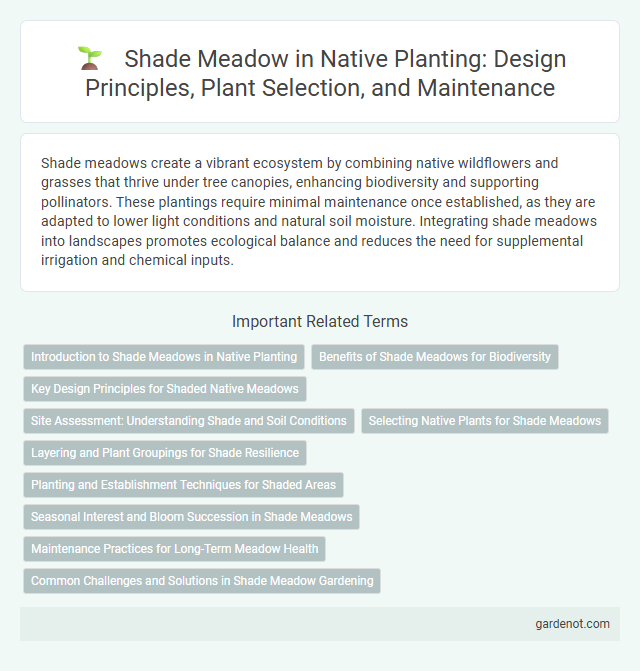Shade meadows create a vibrant ecosystem by combining native wildflowers and grasses that thrive under tree canopies, enhancing biodiversity and supporting pollinators. These plantings require minimal maintenance once established, as they are adapted to lower light conditions and natural soil moisture. Integrating shade meadows into landscapes promotes ecological balance and reduces the need for supplemental irrigation and chemical inputs.
Introduction to Shade Meadows in Native Planting
Shade meadows in native planting consist of a diverse mix of shade-tolerant wildflowers, grasses, and ferns that thrive under tree canopies, creating a lush, low-maintenance landscape. These ecosystems support biodiversity by providing habitat for pollinators and wildlife while improving soil health and moisture retention. Incorporating shade meadows enhances natural beauty and promotes ecological balance in shaded garden areas.
Benefits of Shade Meadows for Biodiversity
Shade meadows provide essential habitats for a variety of native flora and fauna, promoting increased biodiversity in forested ecosystems. These plant communities support pollinators such as bees and butterflies by offering diverse nectar sources, while also serving as shelter and foraging grounds for small mammals and birds. Incorporating native shade meadow species helps enhance soil health and ecological resilience, contributing to the overall stability of local biodiversity networks.
Key Design Principles for Shaded Native Meadows
Key design principles for shaded native meadows include selecting shade-tolerant native plant species such as ferns, wild ginger, and Solomon's seal that thrive under tree canopies. Soil preparation must ensure adequate moisture retention and drainage to support diverse understory growth. Incorporating structural diversity by layering ground covers, herbaceous plants, and low shrubs enhances habitat complexity and ecological resilience.
Site Assessment: Understanding Shade and Soil Conditions
Shade meadow site assessment requires analyzing light levels, including canopy density and duration of shade throughout the day, to select shade-tolerant native plants. Soil evaluation focuses on texture, moisture retention, pH, and nutrient content to ensure optimal growth conditions. Accurate assessment of shade patterns and soil characteristics enhances plant establishment and biodiversity in native shade meadow ecosystems.
Selecting Native Plants for Shade Meadows
Selecting native plants for shade meadows requires identifying species adapted to low-light conditions and moist, well-drained soils. Ideal plants include shade-tolerant ferns, wild ginger (Asarum canadense), and native grasses such as Pennsylvania sedge (Carex pensylvanica), which promote biodiversity and soil health. Incorporating diverse native perennials supports pollinators and creates a sustainable, low-maintenance habitat in shaded environments.
Layering and Plant Groupings for Shade Resilience
Shade meadows thrive by incorporating layered plantings, combining groundcovers, mid-height perennials, and taller shrubs to optimize light capture in low-light environments. Grouping native species with complementary growth habits and moisture needs enhances shade resilience, creating a balanced ecosystem that supports biodiversity. Effective layering and strategic plant groupings improve soil health and suppress weeds, ensuring long-term sustainability in shaded garden spaces.
Planting and Establishment Techniques for Shaded Areas
Shade meadow planting requires selecting native species adapted to low-light conditions, such as woodland wildflowers and shade-tolerant grasses, to ensure successful establishment. Techniques include soil preparation with organic amendments to improve moisture retention and minimize competition from invasive species through regular monitoring and hand weeding. Mulching with natural materials helps conserve soil moisture and regulate temperature, promoting healthier growth in shaded environments.
Seasonal Interest and Bloom Succession in Shade Meadows
Shade meadows offer dynamic seasonal interest with a diverse array of native plants that bloom sequentially from early spring to late fall. Ferns, wild ginger, and trilliums provide lush foliage and early blossoms, while jewelweed and cardinal flower ensure vibrant color into summer and autumn. This bloom succession supports pollinators year-round and enhances understory biodiversity in shaded woodland gardens.
Maintenance Practices for Long-Term Meadow Health
Shade meadow maintenance for long-term health requires regular debris removal to prevent smothering native plants and enhance light penetration. Periodic selective thinning of overstory trees balances shade levels, promoting understory growth and biodiversity. Maintaining soil moisture through mulching and minimizing foot traffic preserves root systems and supports ecosystem stability.
Common Challenges and Solutions in Shade Meadow Gardening
Shade meadow gardening faces common challenges such as limited sunlight, soil moisture variability, and competition with established tree roots. Selecting shade-tolerant native plants like woodland wildflowers and ferns helps address low light conditions while improving biodiversity. Proper soil preparation and mulching enhance moisture retention and reduce weed pressure, ensuring successful growth in shaded environments.
Shade meadow Infographic

 gardenot.com
gardenot.com